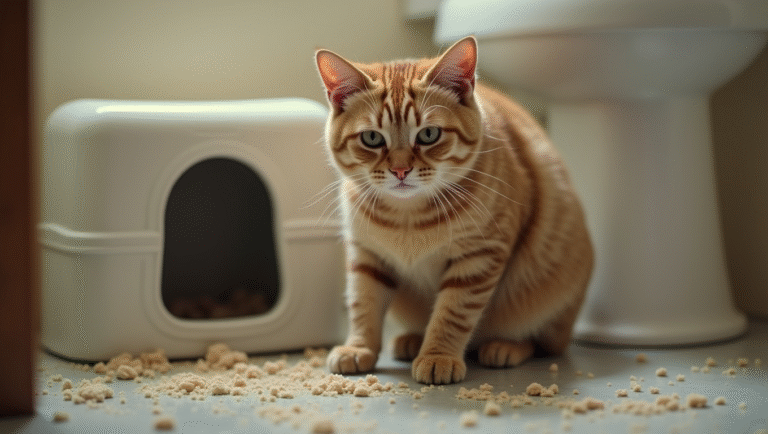Cat Aggression: What to Do When Your Cat Is Aggressive
Has your cat ever jumped, hissed, swatted, or bitten you? This is also known as aggression in cats, and it can happen for several reasons. Whether it’s aggression born out of fear when there’s a loud sound, territorial aggression when a new pet gets introduced, or even aggression due to your petting them enough, all these are perfectly natural with your cat as they try to communicate what they need or don’t want to happen.
Fear-based aggression occurs when your cat begins to swat at something. But in some cases, such aggression is no more than a manifestation of his fear, and Your job now in taking care of him is finding out what makes its other’s rise.
When your cat behaves like defending her turf, It’s not simply the attitude—instinct and probably the Right brain, harkening back to survival itself, that leads them to protect their Territory.

A close-up of an aggressive tabby cat walking with a tense posture, showing intense eyes and slightly forward-facing ears. Its fur displays distinct brown and black stripes, and the cat is set against a natural, rocky outdoor backdrop.
Play-induced aggression: Do they bite you suddenly when you’re playing? It’s not rejection—your cat is saying, ‘This is my limit,” so having good awareness of your cat’s limits is important.
Petting-induced aggression: How many times have I been surprised by a bite during a snuggle session? It is not rejection–your cat is simply saying, ‘I’ve had enough,’ and knowing when to stop is the secret.
Pain-induced aggression: “No matter how sweet your feline buddy usually is, if she suddenly begins to turn aggressive, it could be pain expressing itself in a louder voice than love–knowing her possible discomfort beforehand may help smooth over any hurt feelings.”
Redirected aggression: One moment, your cat’s in a quiet mood, and the next minute (s), he attacks you suddenly and without warning. It may be redirected aggression, in which the frustration of a trigger other than oneself cascades onto oneself.
Knowing these types of aggression will help you better cope with your cat and create a more peaceful environment. With tips for positive reinforcement, changes in your cat’s environment that suit him better, and what to do if you need to consult a veterinarian specializing in animal behavior, you’ll have begun improving your beloved kitten’s life and strengthening the bond between you two.
Fear Aggression in Cats: Why Is Your Kitty Afraid?
Hey, cat parents! Did your darling little kitty suddenly hiss, growl, or even scratch you? Fear aggression is the standard response of a scared and cornered cat, not your pet being mean. The cat wants to say, “I’m scared! Please help me feel safe again.” Knowing these signs of fear-related aggression in cats can help you during these difficult times.
Why is my cat becoming aggressive all of a sudden?
Several things can cause fear aggression:
New or frightening situations: loud sounds, unfamiliar people in the house (i.e., someone walking into your home that they don’t know), or NEW pets could set their fear-based aggression off. 27% of the cats at shelters for aggression are scared; this is how they express it.
Bad memories: a rough trip to the vet or past trauma can make your cat nervous. A past painful condition such as an operation gone wrong or being injured can heighten their fear response and expression of that fear response in aggressive reactions.”
Lack of socialization: cats who weren’t well socialized before their third month (let’s say within the space from 3 to 9 weeks) are more likely to react with fear when encountering new people or experiences.
Personality: Some cats are naturally shy, and fear-related aggression is simply part of their personality. These cats don’t always like physical contact or unfamiliar situations.
What To Look Out For?
Your cat may press its ears flat against its head, crouching low, hairs standing on end and wide open pupils staring at things intensely. Also watch for tail twitching or tail lashing- these can also mean discomfort or fear. 50% of cat bites at the vet’s office come from scared kitties! Hissing, growling, scratching, and biting might follow if they feel cornered.
What You Can Do
• Give them room to hide and relax: Arrange small, cozy hiding spots and provide visual and auditory interest. The more choices they have in their environment, the less likely disputes will erupt over territory .
• Go slow: Gradually expose them to their fears while rewarding calm behavior with food treats. Giving praise and reinforcement helps them to become more comfortable with new experiences.
• Stay calm: NEVER EVER strike out at fear-pained animals yourself; Fear breeds anger, and punishment only makes it worse. Remember, when animals turn their aggression on man is more likely out of fear than ill intent.
• Bring in the experts: Call for a licensed veterinary behaviorist or board-certified feline behavior specialist if a severe case occurs. They will help you develop an individualized, comprehensive treatment plan for cat aggression.
You can transform fear-induced aggression into trust and help your cat feel secure with love and patience!
Why Is Your Cat Defending Their Space? Territorial Aggression in Cats
Hey there, cat parent! So, we’ll understand why your fluffy canine may suddenly act like a tiny lion defending a pride. Cats are inherently territorial — in their DNA, bequeathed from wild predecessors that had to guard their food, shelter, and safety. Even snuggled up at home, this instinct is alive and well, creating territorial behavior.
Why Are Cats Territorial?
Your cat considers their food bowl, litter box, and favorite napping spot as prized possessions. When these resources are threatened, they might respond aggressively. Actually, 73.3% of cat parents bringing a new kitty to the home report initial signs of territorial aggression—such as hissing, chasing, or full-blown fur-flying brawls. Cats are territorial by nature, and any new animal (or even a new human) threatening their sense of security might set it off. This behavior is a survival instinct that enables them to protect their territory.
What Can I Do to Prevent My Cat from Being Aggressive Towards a New Pet?
Introducing a new pet to the household can be a monumental stressor for your cat and can very much trigger territorial aggression. Here’s how to manage it:
Provide each cat with space: Set up separate feeding spots, water bowls, and litter boxes to prevent resource-based aggression.
Slow introductions: Introduce new pets slowly by letting them sniff each other from behind a door or through a baby gate before they make contact.
Provide them with vertical space: Cats are more secure if they have escape routes and high perches to observe the scene from above. Placing cat trees or shelves throughout the home can help mitigate territorial tension.
Use synthetic pheromones: These might help during the introductions to calm your cat. Some products, like Feliway, imitate natural pheromones that decrease anxiety and territorial aggression.
What Are the Symptoms of Territorial Aggression?
Your cat may exhibit all sorts of aggressive behaviors if she’s feeling territorial:
- Hissing or growling
- Swatting or biting
- A fixed gaze, dilated pupils, and stiff fur
- Pursuing or preventing access to resources such as food or litter boxes
The solution for cats that have resorted to acting out through territorial aggression is time. You must understand that these behaviors are their way of asserting dominance or taking back their territory. It’s not personal — it’s merely instinct.

A territorial gray tabby cat stands assertively on a hardwood floor, with its tail straight, ears forward, and fur slightly puffed.
Can you stop Territorial Aggression?
Territorial aggression may not be preventable, particularly when your cat perceives their resources as threatening. But there are ways to de-escalate conflict:
- Stick to a routine: Cats love their routine. Regular feeding times, play sessions, and quiet time will make your cat feel more secure and less territorial.
- Get your cats neutered or spayed: If male cats are unneutered, they’re more likely to exhibit territorial behavior. Spaying or neutering your kitty can minimize some of these territorial instincts.
- Watch other behaviors: Look out for warning signs of aggression—like tense muscles or tail-flicking—and provide your cat space when needed. Avoid force interaction, especially if you think they are upset or defensive.
You can prevent such territorial aggressiveness and promote peaceful cohabitation by controlling the introduction of new pets and having controlled premises for your cat.
Why Is My Cat Suddenly Attacking Me? Redirected Aggression in Cats
Has your sweet kitty ever suddenly attacked you, another pet, or even a piece of furniture? This may be redirected aggression — the behavior that occurs when your cat becomes very agitated by something they can’t get to, like an outdoor stray dog, a loud noise, or a weird smell. Because they can’t attack the source of their frustration, they use that energy to attack whatever’s close — often you!
Why Cats Become Aggressive?
Redirected aggression is driven by frustration, not fear or territorial defense. Here’s what could trigger your cat:
- Outside animals: You may be surprised (or not) to learn that 95% of redirected aggression cases are the cat that reacts to lost cats or birds outside. When your cat spots a target, they can’t reach—a bird outside the window, a stray cat sitting on the porch—they might get angry and aim their aggression at the immediate target.
- Sudden noises: Fireworks, thunderstorms , or even a car backfiring can instantly cause your cat to react aggressively toward people or pets in its home.
- New scents: New people in the home, new furniture, or the smell of another pet can confuse your cat and cause frustration.
- Internal stress: Cats with underlying anxiety, for example, those living in households with multiple cats, may also show redirected aggression because of the stress they feel but cannot leave.
How can I prevent my cat from randomly attacking me?
If redirected aggression does occur, it’s crucial to remember that your cat’s wrath isn’t personal. They reflect frustration.” Here’s how you can take control of the situation:
- Recognize and remove the trigger: If frustration is caused by a stray cat outside, close the blinds or move your cat to another room and close the door so they don’t see the trigger.
- Stay calm and avoid retaliation: If your cat redirects aggression onto you, stay calm. Do not resort to yelling or physical punishment because that can aggravate the behavior and add to stress.
- Provide time and distance: After an episode of redirected aggression, the never-assaulted cat should be allowed to move to a safe, quiet area of your home to settle down.
- Watch for body language: Look for early warning signs, such as dilated pupils, a twitching tail, and a taut posture. These can help you stop an outburst before it starts.
- ·Increase environmental enrichment: Cats sometimes strike out when they’re bored. Offering additional toys, scratching posts, and play sessions can help alleviate some of that pent-up energy and frustration.
Why does your kitty play rough? Play aggression in cats
Does your kitty make playtime seem like an all-out wrestling match, including biting and scratching? That’s known as play aggression and is extremely common in young cats under 2 years. It’s not that they’re being malicious; your cat is honing their built-in predator instinct. Let’s explore why this occurs and what you can do to contribute.

Playful tabby kitten mid-pounce with open mouth and wide eyes, showing playful aggression while chasing red yarn ball in a bright, cozy indoor setting.
Why Do Cats Engage in Play Aggression?
What is cat play aggression?
Play aggression is a matter of instinct and energy. Cats are natural predators, so behaviors such as stalking, pouncing, and biting are in their DNA. But sometimes, they may engage in rough play because of following reasons:
- Socialization issues: Kittens raised without other kittens may not learn to play gently. Without the positive reinforcement of healthy play with their littermates, they may turn to brutally playing with their humans instead.
- Boredom: Cats often turn to rough play if they don’t have enough stimulation.
- Bad play habits: Playing with your hands or feet teaches them you are prey.
According to studies, play aggression is one of the most common problems among cats, affecting 40% of cat owners.
How to Manage It
• Redirect that energy with toys like feather wands or laser pointers away from your hands and feet.
• Spend 10–15 minutes twice a day playing to burn off excess energy. Providing an outlet for your cat’s desire to hunt will help prevent an aggressive response.
• Never use your hands or feet as toys — it only reinforces bad habits and may make them more prone to bite or swat.
• Rotate toys and provide scratching posts and climbing trees to keep them entertained and discourage unwanted behavior from developing.
With lots of patience and proper play techniques, you can focus your kitty’s playful energy on safe, fun interactions with you.
Why Does My Cat All of a Sudden Bite Me?
Why Cats Might Get Aggressive When You Pet Them
Have you ever been in a cuddle with your kitty when they suddenly bite, swat, or run away? That’s known as petting-induced aggression, and it’s surprisingly common—experts estimate that it accounts for as much as 40% of all feline aggression cases. Don’t fret, though — it’s not personal; it’s not that they don’t like you. It’s their sense of saying, “I’m done.”
Why Does It Happen?
• Overstimulation: Too much petting can annoy your cat. Research suggests that touch can activate discomfort pathways, leading to aggressive responses.
• Sensitive Spots: Most cats do not appreciate their belly, tail, or back being touched. These are common body regions where most pets suddenly become aggressive.
• Stress or Pain: Health conditions like arthritis can render touch painful.
Medical issues: Cats in pain, whether related to a specific illness or arthritis, can also lash out when petted.
• Socialization: Cats that weren’t handled very much early in life may tolerate petting less, and if the trigger to aggressive behavior is physical contact, then physical contact from a human will elicit aggressive behavior.

Tabby cat swatting at human hand in cozy living room, reacting to overstimulation with defensive body language and flattened ears.
How to Avoid It
• Let your cat choose when and where to be petted — head and chin are generally safe.
• Close sessions before warning signs such as tail flicking, flattened ears, or restlessness appear.
• Use food treats for calm behavior to reinforce trust.
• Do not punish them, as this will only increase fear-related aggression and harm your relationship with them.
Why Is My Cat Behaving Aggressively Out of the Blue? How to Avoid Pain-Induced Aggression
Does your sweet, cuddly kitty suddenly hiss, growl, or swat when you go to pet them? Don’t worry—you’re not alone. They could be coping with our most common behavior, pain aggression, which is their way of saying, “I’m in pain; please, give me some space.”
For instance, declawed cats are 8.9 times more likely to act aggressively due to residual pain from the procedure. Painful conditions, such as arthritis (which affects up to 90 percent of senior cats), dental issues, or injuries, can cause them to lash out as a means of protecting themselves from more pain.
Signs That Your Cat May Be In Pain
• Uncharacteristic aggression, accompanied by limping, hiding, decreased activity and/or over-grooming, and/or decreased appetite.
• They can also show signs of pain by having tense body posture, dilated pupils, or tail twitching.

Injured tabby cat limping on carpet in home, showing signs of pain with hunched posture and flat ears, evoking empathy and concern.
What You Can Do for Your Cat’s Pain-Induced Aggression
• See the vet: An in-depth check-up is essential to determine the source of pain, like arthritis or dental problems.
Avoid sensitive spots: Don’t put your hands on parts of your cat’s body that seem to elicit discomfort—your cat needs room to heal.
Ease life: Offer padded bedding, ramps, or steps to prevent jumping and keep food and water bowls within reach.
As long as you respect your cat’s limits and learn to pay attention to their signals, you can snuggle with your kitty with minimal stress!
• Rebuild trust: Treats and gentle handling can create positive associations with touch.
• Be patient: Never punish aggression — this only adds to fear and stress.
Conclusion With love and care, your cat will feel safe
Cat aggression can arise from fear, pain, or natural territorial tendencies, but knowing what and why is the first step toward finding a solution. Understanding the signs of each type of aggression (fear-based, territorial, and petting-induced) allows you to make your kitty feel safe and secure.

Peaceful orange tabby cat lying on soft blanket near sunlit window, symbolizing calm behavior and resolution of cat aggression in cozy home setting.
Aggression can be reduced, and your bond with your furry friend can be strengthened with a positive environment, reinforcement, and patience. A veterinary behaviorist can help you design a more personalized approach if necessary.
Faqs
· Why is my unneutered cat more aggressive?
Unneutered cats (especially males) have high hormone levels driving territorial and mating urges, which can make them more aggressive
. Neutering removes these hormone triggers and often leads to a calmer, gentler cat.
· How can I stop my cats from fighting each other?
Cats in the same home may fight over territory or hierarchy. Provide each cat with their own food bowls, litter boxes, and beds to reduce competition. If a fight occurs, separate them and reintroduce gradually with positive reinforcement. Patience and giving them space can help restore harmony.
· Why is my cat aggressive at night?Cats are naturally more active at night due to their hunting instincts. Your cat might pounce or bite during nighttime “zoomies” out of excess energy or boredom. A vigorous play session in the evening and a small bedtime feeding can help them settle down and sleep.
· Why is my cat aggressive toward guests?
Cats often see unfamiliar visitors as potential threats. A shy or territorial cat might hiss, growl or swat at guests because they’re scared of the new person. It’s usually defensive. Let your cat have a quiet room or high perch to retreat to when visitors come over, so they feel safe.
· Why is my cat aggressive toward children?
Young kids can unintentionally scare or provoke cats. Children might miss a cat’s warning signs and handle them too roughly or loudly. Many cats hiss or scratch to set boundaries. Always supervise playtime and teach kids to be gentle and respect the cat’s space so everyone stays safe.
· Can my cat’s diet cause aggression?
Diet itself isn’t a direct cause of aggression, but feeding habits matter. A cat that’s hungry or only fed once or twice a day may get irritable and aggressive around mealtimes. In fact, cats meal-fed on strict schedules showed more aggression than those free-fed in one study. Try offering smaller, more frequent meals to keep your cat satisfied.
· Could a health problem be causing my cat’s aggression?
Absolutely. Pain or illness can turn a sweet cat grouchy. Conditions like hyperthyroidism (overactive thyroid), epilepsy, untreated infections, or even cognitive decline in old age can trigger sudden aggressionbehavior shifts unexpectedly, have a vet check for underlying medical issues.







